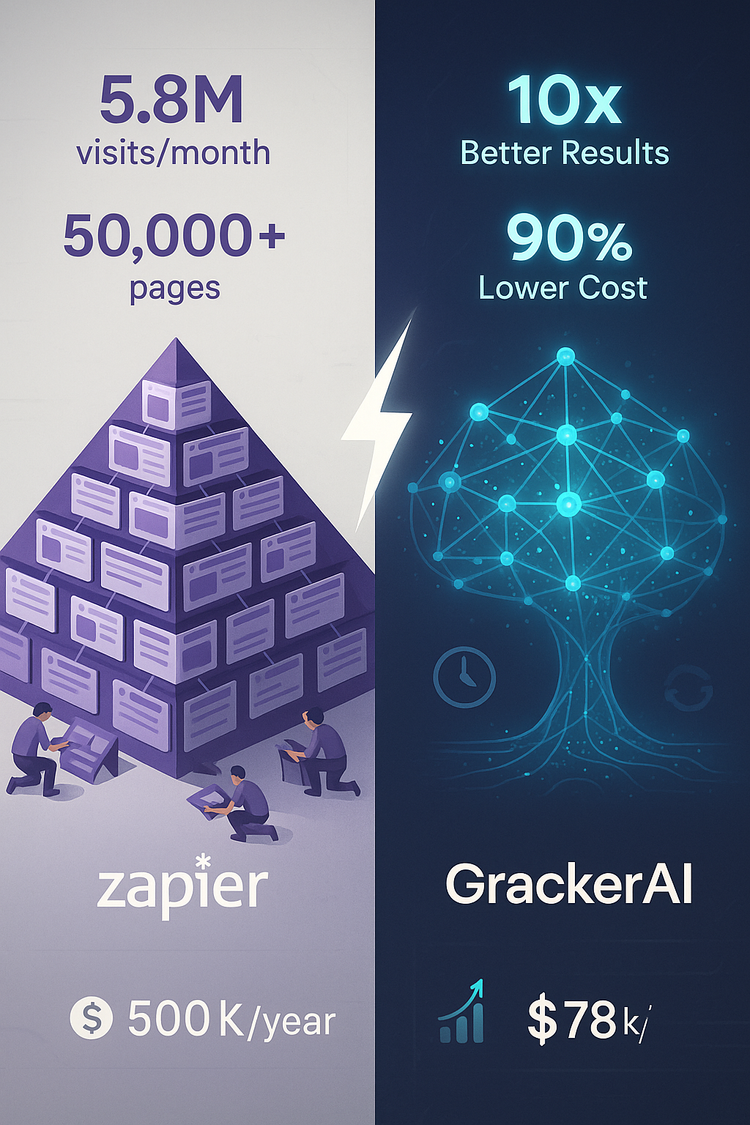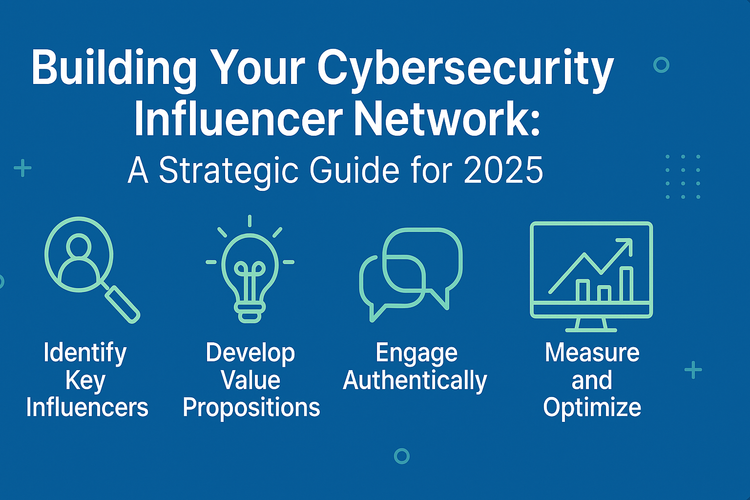Keyword Research Tips for Cybersecurity SEO

Introduction
In the crowded world of cybersecurity, gaining visibility on search engines can be a daunting task. With evolving threats, complex technical language, and fierce competition, how can your cybersecurity business rank higher and capture relevant traffic? The answer lies in Keyword Research for Cybersecurity SEO. By understanding the unique nature of cybersecurity terms, using the right tools, and focusing on user intent, you can optimize your content to meet the needs of your target audience.
In this blog, we'll dive into actionable keyword research strategies, using real-life examples, visual aids, and practical tips to help you boost your SEO for cyber security efforts.
Understanding the Unique Nature of Cybersecurity Keywords
Cybersecurity keywords are often more technical than those in other industries. They involve terms that are specific to the cybersecurity field, such as “malware protection,” “data encryption,” and “firewall solutions.” These keywords can be difficult to rank for, especially because many companies are competing for the same search terms.
Real-life Example:
- McAfee, a global leader in cybersecurity solutions, ranks highly for broad terms like "antivirus software" and "cybersecurity protection." However, they also target niche long-tail keywords such as "best antivirus for small businesses" to attract a more targeted audience.
When conducting keyword research, focusing on long-tail keywords is essential. These keywords tend to be more specific and have lower competition, making it easier for your content to rank. For instance, instead of targeting the broad keyword "cybersecurity," consider keywords like "affordable cybersecurity services for small businesses" or "data encryption for healthcare organizations."
Keyword Research Tips for Cybersecurity SEO
Effective keyword research for cybersecurity SEO requires a strategic approach. Here are some tips to help refine your research:
-
Use Niche-Specific Tools:
Use industry-specific keyword tools that cater to the technical nature of cybersecurity. For instance, tools like SEMrush and Ahrefs can help you track highly specific cybersecurity keywords that are harder to find on generic tools like Google Keyword Planner.
-
Focus on Problem-Solving Keywords:
Cybersecurity is all about solving problems. Search terms like "how to prevent ransomware attacks" or "best firewall for remote workers" often have a high search intent and low competition. Focus on keywords that match common cybersecurity challenges.
-
Leverage Google’s Related Searches:
As mentioned earlier, Google’s related searches and “People also ask” sections provide valuable insights into long-tail keywords. If you're targeting broad cybersecurity topics, refine them by analyzing the suggested related searches like "cybersecurity tips for SMBs" or "enterprise security solutions."
-
Monitor Keyword Trends:
Use Google Trends to spot rising keywords in the cybersecurity industry. Keywords that are gaining search volume now can help you capitalize on new market shifts before your competitors do.
-
Think About the Buyer’s Journey:
Understanding the buyer’s journey is crucial for selecting the right keywords. For example:
-
Top of the Funnel (TOFU): Focus on informational keywords like "What is cybersecurity?" or "Why do small businesses need cybersecurity?"
-
Middle of the Funnel (MOFU): Target keywords like "Best cybersecurity solutions for small business."
-
Bottom of the Funnel (BOFU): Optimize for transactional keywords like "Hire cybersecurity experts near me."
Types of Keywords to Focus On
In Cyber security SEO, you should focus on three main types of keywords:
1. Informational Keywords
Informational keywords are terms that users search for when they want to learn more about cybersecurity topics, threats, and solutions. These keywords are great for generating traffic and positioning your brand as a knowledgeable resource in cybersecurity, although they may not immediately convert into sales.
-
Example: "How does cybersecurity work?"
This search query attracts users curious about the basics of cybersecurity, looking to understand what it entails and why it’s essential. By creating content that addresses such questions, like a detailed blog or a beginner’s guide, you can build trust and authority, bringing users to your site who may later convert as they explore more advanced content. -
Other Examples: "Types of cyber threats," "Best practices for network security," "How to prevent phishing attacks."
These keywords often have high search volume and can drive significant traffic by reaching users interested in cybersecurity education and best practices.
2. Navigational Keywords
Navigational keywords are used by users looking for a particular product, service, or brand in cybersecurity. These users are often in the consideration stage of their buying journey and are familiar with specific offerings. Targeting these keywords can attract users who are closer to making a decision and have a particular brand or type of service in mind.
-
Example: "Best firewall for small business."
This search query indicates that the user is interested in finding firewall solutions tailored to small businesses. By optimizing for this keyword, you can direct users to a comparison page, review, or product page that highlights relevant options, positioning your brand as a viable solution. -
Other Examples: "Norton antivirus download," "CrowdStrike pricing," "Kaspersky for enterprises."
These keywords can drive qualified traffic from users already considering certain brands or types of cybersecurity software.
3. Transactional Keywords
Transactional keywords show that the user is ready to take action, such as making a purchase or contacting a provider. These are high-conversion keywords that indicate strong buying intent and are ideal for driving leads.
-
Example: "Hire a cybersecurity expert."
A user searching for this is likely seeking professional services and may be ready to contact a provider. Creating dedicated landing pages or service descriptions optimized for such keywords can significantly boost conversions, as they directly address users prepared to engage or buy. -
Other Examples: "Buy endpoint protection software," "Get a cybersecurity audit," "Best cybersecurity consulting service."
These keywords help capture leads by targeting users actively seeking to invest in cybersecurity solutions.
Why Focus on These Keyword Types?
By strategically targeting informational, navigational, and transactional keywords, you can create a balanced content strategy that reaches users at all stages of the buying cycle. Informational keywords help build awareness and trust, navigational keywords attract those evaluating options, and transactional keywords drive conversions from users ready to take action. For Cybersecurity SEO, this approach ensures that your content meets the varying needs of potential customers, ultimately increasing traffic, engagement, and conversions.
How to find keywords Cybersecurity SEO?
Using Google’s Autocomplete and Related Searches
Google’s Autocomplete and Related Searches are gold mines for discovering valuable keywords. Here's how you can use them:
-
Autocomplete:
When you start typing a search query, Google offers suggestions based on common searches. For instance, typing "cybersecurity" may suggest "cybersecurity services for businesses" or "cybersecurity certification."
-
Related Searches:
At the bottom of Google’s search results page, you'll find related searches that can help you expand your keyword list. For example, if you search for "best cybersecurity software," related searches might include "top firewall software" or "affordable cybersecurity solutions."
These features help you discover popular, high-volume search terms, providing fresh keyword ideas that are highly relevant to your audience.
Keyword Research Tools for Cybersecurity SEO
Several tools can help refine your Cybersecurity SEO keyword strategy:
1. Google Keyword Planner
-
Free Tool: Google Keyword Planner is entirely free, making it an excellent starting point for small businesses and beginners.
-
Keyword Insights: It offers detailed insights into keyword search volume, competition level, and seasonal trends. These insights help you understand how often users search for specific terms and how competitive those keywords are.
-
Targeting Location: Google Keyword Planner allows you to filter results based on location, so you can target specific geographic regions, which is especially useful for local SEO efforts in cybersecurity.
-
Keyword Suggestions: The tool provides a list of related keywords, helping you discover new long-tail keywords relevant to your cybersecurity business. This is valuable for uncovering niche terms that have lower competition.
-
Ad Performance: Since Google Keyword Planner is primarily used for PPC (Pay-Per-Click) ads, it offers suggestions on bidding costs, providing an understanding of how much you'll need to spend to rank for certain keywords.
2. SEMrush
-
Paid Tool: SEMrush is a paid tool offering comprehensive features for businesses serious about SEO and competitive analysis.
-
Competitor Analysis: One of SEMrush’s standout features is its ability to analyze competitors' keyword strategies. You can identify which keywords your competitors are ranking for, providing valuable insights to refine your own strategy.
-
Keyword Tracking: SEMrush tracks your keywords’ rankings over time, allowing you to monitor performance, identify trends, and adjust strategies accordingly.
-
Keyword Difficulty Score: SEMrush evaluates keyword difficulty, helping you prioritize keywords that are easier to rank for while also identifying the most competitive ones.
-
Content Optimization: With its SEO writing assistant, SEMrush helps you optimize content by suggesting related keywords, analyzing competitors, and checking readability.
3. Ahrefs
-
Comprehensive Backlink Analysis: Ahrefs is known for its backlink analysis, but it also provides in-depth keyword metrics such as search volume, keyword difficulty, and click-through rates (CTR). This is crucial for understanding not just how often a term is searched, but how competitive it is and what kind of traffic it might generate.
-
Keyword Difficulty (KD): Ahrefs offers a keyword difficulty score that helps you evaluate how tough it will be to rank for a particular keyword.
-
Search Volume Insights: Ahrefs provides real-time data on search volume, which gives a clear idea of how much traffic you can expect if you rank for a specific keyword.
-
Content Gap Analysis: Ahrefs also allows you to identify content gaps—keywords your competitors are ranking for but you are not. This can uncover new opportunities for ranking in the cybersecurity space.
4. Moz Keyword Explorer
-
User Intent-Based Suggestions: Moz’s Keyword Explorer uses data to suggest keywords based on user intent, meaning you can target keywords aligned with what users are searching for in relation to cybersecurity.
-
Keyword Difficulty Score: Moz assigns a keyword difficulty score, helping you decide whether a keyword is worth targeting. It also provides a priority score that combines search volume and difficulty.
-
SERP Features Insights: Moz also shows you what SERP features (such as featured snippets, knowledge panels, etc.) are appearing for your keywords, allowing you to strategize on how to capture these prime spots.
-
Keyword Recommendations: Moz’s Keyword Explorer offers keyword suggestions and related terms to help expand your list of target keywords. It also includes long-tail keywords, which can be more attainable and useful for SEO for cyber security.
By using these tools, you can create a well-rounded keyword strategy for your SEO for cyber security efforts.
Competitor Keyword Analysis
Understanding your competitors’ keyword strategies is crucial to staying ahead. Here’s how you can analyze your competitors' SEO for cybersecurity:
1. Identify Competitors
Begin by identifying primary competitors who dominate the cybersecurity landscape. Major companies like Norton, CrowdStrike, and McAfee have extensive keyword strategies, targeting broad terms as well as niche topics. If you offer antivirus or cybersecurity solutions, consider these companies as benchmarks.
- Example: Norton is well-known for “antivirus software” keywords. However, they also target specific markets with keywords like “antivirus for small business” or “antivirus for remote workers.” By analyzing Norton’s focus on these niches, a smaller cybersecurity company could identify unique keyword opportunities relevant to their target market (e.g., “antivirus for freelancers” or “antivirus for healthcare”).
2. Use SEMrush or Ahrefs for Keyword Tracking
Tools like SEMrush and Ahrefs allow you to dive deep into competitors’ keyword strategies. You can track the keywords they’re ranking for, understand their search volume, keyword difficulty, and spot any gaps in their approach.
- Example: Using SEMrush to analyze CrowdStrike, a company known for endpoint protection, may reveal that they rank for high-value keywords such as “endpoint security for enterprises” or “threat intelligence solutions.” However, you may find they’re not targeting niche long-tail keywords like “endpoint security for remote work” or “threat intelligence for small businesses.” These gaps are opportunities for smaller companies to create highly targeted content that could rank more easily.
Understanding User Intent in Cybersecurity Keywords
User intent refers to the purpose behind a search query and is crucial for effective keyword research and SEO. There are three main types of user intent: Informational, Navigational, and Transactional.
1. Informational Intent
Users with informational intent are seeking knowledge or answers to questions. They’re not ready to make a purchase but want to learn more about a topic.
- Example: "What is a cybersecurity breach?"
This user wants to understand the concept of a cybersecurity breach, which is a common informational search for those researching cybersecurity.
2. Navigational Intent
Navigational intent users are searching for a specific brand, product, or service. They know what they want and need to find a specific website or page.
- Example: "Norton antivirus for enterprises"
The user is looking specifically for Norton’s antivirus solution for businesses, indicating they already recognize the brand and product.
3. Transactional Intent
Transactional intent indicates that the user is ready to make a purchase or take an action, such as contacting a service provider or buying a product.
- Example: "Hire a cybersecurity consultant"
Here, the user is looking to hire a professional for cybersecurity services, signalling readiness to take action and likely make a purchase or engage a service.
By understanding and optimizing for these intents, businesses can tailor content and keywords to better match users' needs at each stage of their journey. For cybersecurity SEO, targeting informational keywords can raise awareness, while transactional keywords help convert users into customers.
Utilizing Local SEO for Cybersecurity
If you're targeting a local audience, Local SEO is crucial. Use location-specific keywords like “cybersecurity services in [city]” to attract local clients. For example, a company based in Los Angeles might target keywords like "cybersecurity consulting Los Angeles."
-
Google My Business: Ensure your business is listed with accurate information and reviews to rank higher in local search results.
-
Local Listings: Being listed in local business directories can also improve your visibility.
Keyword Difficulty and Search Volume
When evaluating potential keywords for your SEO for cyber security strategy, balance the keyword difficulty (KD) with search volume:
-
Keyword Difficulty (KD): A higher KD means more competition. Use tools like Ahrefs or SEMrush to assess how hard it is to rank for a given keyword.
-
Search Volume: Higher search volume indicates a larger audience, but it also means more competition. Focus on long-tail keywords with a manageable KD and relevant search volume.
Example:
-
High Volume, High Difficulty: "cybersecurity"
-
Low Volume, Low Difficulty: "affordable cybersecurity for small business"
Target a mix of both types to build a balanced SEO strategy.
Optimizing Content Around Target Keywords
Optimizing content around target keywords is essential for improving your search visibility and attracting the right audience. Here’s how you can effectively optimize content through on-page SEO, content quality, and internal linking.
1. On-Page SEO
-
Keyword Placement: Strategically incorporate target keywords into the most visible parts of your content, including the title, headers (H1, H2), and meta descriptions. This helps search engines understand the main topic and relevance of your page.
-
Natural Integration: Use keywords naturally throughout the content without overstuffing. Place them in the introduction, key sections, and conclusion to improve readability and SEO.
-
Alt Text for Images: Adding keywords to image alt text also enhances SEO, as search engines index images based on alt descriptions, helping your page rank in image searches.
2. Content Quality
-
In-Depth Information: High-quality, informative content that thoroughly addresses user needs is key. Google prioritizes content that provides in-depth answers, as this enhances user experience and retention.
-
Unique Value: Offer unique insights or solutions tailored to your audience’s needs. For example, if you're writing for a cybersecurity audience, add case studies, practical examples, or expert advice to stand out.
-
Readability: Use clear language, short paragraphs, and bullet points for easy reading. Quality content that’s easy to digest is more likely to rank well and engage readers.
3. Internal Linking
-
Relevant Links: Link to related pages on your website, guiding users to more resources or deeper insights. This keeps visitors on your site longer and helps distribute SEO authority across pages.
-
Improving Navigation: Use descriptive anchor text to indicate what the linked page offers, helping users and search engines navigate your site more effectively.
-
Building Topic Clusters: Internal linking helps create clusters around key topics (e.g., "cybersecurity best practices"), which signals content depth and relevance to search engines.
Tracking and Updating Keywords
SEO is an ongoing process. Regularly monitor your keyword performance using tools like Google Analytics or Ahrefs. Update your keyword strategy based on performance metrics and industry trends. Reassess your keywords every 3–6 months to stay ahead of the competition.
Conclusion
Effective Cybersecurity SEO starts with robust keyword research. By targeting the right keywords, understanding user intent, and leveraging competitor insights, you can improve your rankings and drive targeted traffic to your cybersecurity website. Don't forget to regularly update your strategy and track performance to stay ahead in the competitive cybersecurity space.
Start implementing these keyword research tips today to boost your visibility and lead generation efforts. And if you need help, try Gracker AI’s advanced keyword research tools to take your SEO for cyber security to the next level.




